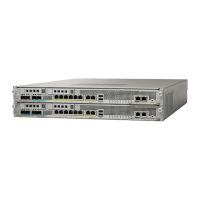6 Silicon Switch Processor (SSP) Installation and Configuration
Prerequisites
Prerequisites
Before you begin the installation of the SSP, review the tools and parts required, and the safety and
ESD-prevention guidelines in this section.
Tools and Parts Required
You need some or all of the following tools and parts to perform the following procedures. Before
you begin, read the entire procedure to determine which tools you need for the installation or
upgrade you will perform.
• A number 1 Phillips or 1/4-inch flat-blade screwdriver for the captive installation screws that
secure the SSP in its slot. (Because of ongoing product improvements, some power supplies use
slotted screws, and others use Phillips head screws.)
• ESD-prevention equipment or the disposable grounding wrist strap included with all upgrade
kits.
• Antistatic mat, foam pad, or bag for the removedSSP, or Switch Processor (SP) if you are making
an upgrade to an SSP. (Immediately place the removed SSP or SP into an antistatic bag if
returning the SSP to the factory.)
Safety
Follow these basic guidelines when working with any electrical equipment:
• Before beginning any procedures requiring access to the chassis interior, locate the emergency
power-off switch for the room in which you are working.
• Disconnect all power and external cables before moving a chassis.
• Do not work alone if potentially hazardous conditions exist.
• Never assume that power is disconnected from a circuit; always check.
• Do not perform any action that creates a potential hazard to people or makes the equipment
unsafe.
• Carefully examine your work area for possible hazards such as moist floors, ungrounded power
extension cables, and missing safety grounds.
In addition, use the guidelines that follow when working with any equipment that is connected to
telephone wiring or other network cabling.
• Never install telephone wiring during a lightning storm.
• Never install telephone jacks in wet locations unless the jack is specifically designed for
wet locations.
• Never touch uninsulated telephone wires or terminals unless the telephone line is been
disconnected at the network interface.
• Use caution when installing or modifying telephone lines.

